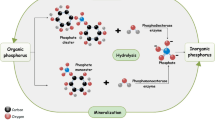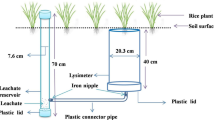Abstract
In this study, the performance of a laboratory-scale soil aquifer treatment (SAT) system was investigated and treatability studies were done in order to determine organic matter removal from synthetic wastewater (SWW) and secondary treated real wastewater (RWW). The SAT system was constructed in laboratory conditions and treatability studies were conducted using soil columns, which were packed with silt loam soil samples. Each column was equipped with a series of ports at multiple depths from soil surface (10, 20, 30, 50, and 75 cm) to collect water samples. Two operational cycles were applied to represent the influence of different wetting and drying periods during wastewater application. Dissolved oxygen, chemical oxygen demand (COD), and total organic carbon (TOC) concentrations were measured in all samples. Average removal values of 61.4 % (COD) and 68.2 % (TOC) were achieved by in SWW and of 58.3 % (COD) and 51.1 % (TOC) in RWW in 55 and 25 weeks of operation, respectively. These results indicated that the performance of the columns operated with SWW was better than the performance of the columns operated with RWW. In essence, the easily biodegradable portion of organic matter was quickly consumed by microorganisms in the first 10 cm of the columns where oxygen levels peaked. Complex organic compounds that are likely to be found in RWW could thus be removed when longer residence times were achieved through the columns. When the removal performances achieved with different operating cycles were compared for each wastewater, it could be seen that longer wetting and longer drying periods yielded higher removal efficiencies in RWW and vice versa in SWW.









Similar content being viewed by others
References
Akber, A., Mukhopadhyay, A., Al-Senafy, M., Al-Haddad, A., Al-Awadi, E., & Al-Qallaf, H. (2008). Feasibility of long-term irrigation as a treatment method for municipal wastewater using natural soil in Kuwait. Agricultural Water Management, 95, 233–242.
Amy, G., & Drewes, J. (2007). Soil aquifer treatment (SAT) as a natural and sustainable wastewater reclamation/reuse technology: Fate of wastewater effluent organic matter (EfOM) and trace organic compounds. Environmental Monitoring and Assessment, 129(1–3), 19–26.
Atals, R.M., & Bartha, R. (1998). Microbial ecology: Fundamentals and applications (4th ed., pp. 300–350). Menlo Park: Addison Wesley Longman, Inc.
Candela, L., Fabregat, S., Josa, A., Suriol, J., Vigues, N., & Mas, J. (2007). Assessment of soil and groundwater impacts by treated urban wastewater reuse. A case study: Application in a golf course (Girona, Spain). Science of the Total Environment, 374, 26–35.
Cha, W., Choi, H., Kim, J., & Kim, I. S. (2004). Evaluation of wastewater effluents for soil aquifer treatment in South Korea. Water Science and Technology, 50(2), 315–322.
Drewes, J. E., & Jekel, M. (1998). Behavior of DOC and AOX using advanced treated wastewater for groundwater recharge. Water Research, 32, 3125–3133.
Drewes, J. E., Reinhard, M., & Fox, P. (2003). Comparing microfiltration-reverse osmosis and soil-aquifer treatment for indirect potable reuse of water. Water Research, 37(15), 3612–3621.
Ernst, M., Sachse, A., Steinberg, C. E. W., & Jekel, M. (2000). Characterization of the DOC in nanofiltration permeates of a tertiary effluent. Water Research, 34(11), 2879–2886.
Essandoh, H. M. K., Tizaoui, C., Mohamed, M. H. A., Amyc, G., & Brdjanovic, D. (2011). Soil aquifer treatment of artificial wastewater under saturated conditions. Water Research, 45(14), 4211–4226.
Fox, P., Narayanaswamy, K., Genz, A., & Drewes, J. E. (2001). Water quality transformations during soil aquifer treatment at the Mesa Northwest Water Reclamation Plant, USA. Water Science and Technology, 43(10), 343–350.
Fox, P., Aboshanp, W., & Alsamadi, B. (2005). Analysis of soils to demonstrate sustained organic carbon removal during soil aquifer treatment. Environmental Quality, 34, 156–163.
Funderburg, S. W., Moore, B. E., Sorber, C. A., & Sagik, B. P. (1979). Method of soil column preparation for the evaluation of viral transport. Applied and Environmental Microbiology, 38(1), 102–107.
Gocmez, S. (2006). Effects of IZSU municipal waste treatment sludge on microbial biomass and activity, some physical and chemical properties of soils in Menemen plain. Ph.D. thesis, Ege University, Bornova, Turkey.
Greenberg, A.E., Clesceri, L.S., & Eaton, A.D. Eds. (1989). Standard methods for the examination of water and wastewater (17th ed.). Washington, DC: American Public Health Association (APHA).
Gunduz, O., & Simsek, C. (2007). Assessment of three wastewater treatment plants in Turkey. In M. K. Zaidi (Ed.), Wastewater reuse-risk assessment, decision-making and environmental security NATO science for peace and security series (pp. 159–167). Netherlands: Springer.
Gungor, K., & Unlu, K. (2005). Nitrite and nitrate removal efficiencies of soil aquifer treatment columns. Turkish Journal of Engineering and Environmental Sciences, 29, 159–170.
Hussain, S., Aziz, H. A., Isa, M. H., Adlan, M. N., & Asaari, F. A. H. (2006). Physico-chemical method for ammonia removal from synthetic wastewater using limestone and GAC in batch and column studies. Bioresource Technology, 98, 874–880.
Idelovitch, E. (2003). SAT (soil aquifer treatment)—The long-term performance of the Dan Region reclamation project. Washington, DC: The World Bank Water Week.
Idelovitch, E., Icekson-Tal, N., Avraham, O., & Michail, M. (2003). The long-term performance of soil aquifer treatment (SAT) for effluent reuse. Water Science and Technology: Water Supply, 3(4), 239–246.
IZSU. (2010). Wastewater characteristics of Cigli Treatment Plant, Izmir Water and Sewerage Administration. Retrieved March 12, 2010, from http://www.izsu.gov.tr.
Laws, B. V., Dickenson, E. R. V., Johnson, T. A., Snyder, S. A., & Drewes, J. E. (2011). Attenuation of contaminants of emerging concern during surface-spreading aquifer recharge. Science of the Total Environment, 409(6), 1087–1094.
Lee, S. Y., Lee, J. U., Choi, H., & Kim, K. W. (2004). Sorption behaviors of heavy metals in SAT (soil aquifer treatment) system. Water Science and Technology, 50(2), 263–268.
Metcalf and Eddy, Inc. (1991). Wastewater engineering: Treatment and reuse (3rd ed.). Singapore: McGraw Hill, Inc.
Nadav, I., Arye, G., Tarchitzky, J., & Chen, Y. (2012). Enhanced infiltration regime for treated-wastewater purification in soil aquifer treatment (SAT). Journal of Hydrology, 420–421, 275–283.
Nema, P., Ojha, C. S. P., Kumar, A., & Khanna, P. (2001). Techno-economic evaluation of soil-aquifer treatment using primary effluent at Ahmedabad, India. Water Resource, 35(9), 2179–2190.
Ogunmwonyi, I. N., Igbinosa, O. E., Aiyegoro, O. A., & Odjadjare, E. E. (2008). Microbial analysis of different top soil samples of selected site in Obafemi Awolowo University, Nigeria. Scientific Research and Essay, 3(3), 120–124.
Quanrud, D. M., Arnold, R. G., Wilson, L. G., & Conklin, M. H. (1996). Effect of soil type on water quality improvement during soil aquifer treatment. Water Science and Technology, 33(10–11), 419–431.
Quanrud, D. M., Arnold, R. G., Lansey, K. E., Begay, C., Ela, W., & Gandolfi, A. J. (2003a). Fate of effluent organic matter during soil aquifer treatment: Biodegradability, chlorine reactivity and genotoxicity. Journal of Water and Health, 01(1), 33–44.
Quanrud, D. M., Hafer, J., Karpiscak, M. M., Zhang, J., Lansey, K. E., & Arnold, R. G. (2003b). Fate of organics during soil-aquifer treatment: Sustainability of removals in the field. Water Research, 37, 3401–3411.
Rauch, T., & Drewes, J. E. (2004). Assessing the removal potential of soil-aquifer treatment systems for bulk organic matter. Water Science and Technology, 50(2), 245–253.
Rauch, T., & Drewes, J. E. (2005). Quantifying biological organic carbon removal in groundwater recharge systems. Journal of Environmental Engineering, 131(6), 909–923.
Rauch, T., & Drewes, J. E. (2006). Using soil biomass as an indicator for the biological removal of effluent-derived organic carbon during soil infiltration. Water Research, 40, 961–968.
Sharma, S. K., Harun, C. M., & Amy, G. (2008). Framework for assessment of performance of soil aquifer treatment systems. Water Science and Technology, 57(6), 941–946.
Shuang, X., QingLiang, Z., LiangLiang, W., LiNa, W., & ZhiGang, L. (2007). Fate of secondary effluent dissolved organic matter during soil-aquifer treatment. Chinese Science Bulletin, 52(18), 2496–2505.
Thawale, P. R., Juwarkar, A. A., & Singh, S. K. (2006). Resource conservation through land treatment of municipal wastewater. Current Science, 90(5,10), 704–711.
Viswanathan, M. N., Al Senafy, M. N., Rashid, T., Al-Awadi, E., & Al-Fahad, K. (1999). Improvement of tertiary wastewater quality by soil aquifer treatment. Water Science and Technology, 40(7), 159–163.
Wall, D. H., & Virginia, R. A. (1999). Controls on soil biodiversity: Insights from extreme environments. Applied Soil Ecology, 13(3), 137–150.
Westerhoff, P., & Pinney, M. (2000). Dissolved organic carbon transformations during laboratory-scale groundwater recharge using lagoon-treated wastewater. Waste Management, 20, 75–83.
Wilson, L. G., Amy, G. L., Gerba, C. P., Gordon, H., Johnson, B., & Miller, J. (1995). Water quality changes during soil aquifer treatment of tertiary effluent. Water Environment Research, 67(3), 371–376.
Xue, S., Zhao, Q. L., Wei, L. L., & Wang, L. N. (2008). Reduction of dissolved organic matter and trihalomethane formation potential during laboratory-scale soil-aquifer treatment. Water and Environmental Journal, 22, 148–154.
Xue, S., Zhao, Q., Wei, L., & Rena, N. (2009). Behavior and characteristics of dissolved organic matter during column studies of soil aquifer treatment. Water Research, 43, 499–507.
Yu, J. T., Bouwer, E. J., & Coelhan, M. (2006). Occurrence and biodegradability studies of selected pharmaceuticals and personal care products in sewage effluent. Agricultural Water Management, 86, 72–80.
Yun-zheng, P. I., & Jian-long, W. (2006). A field study of advanced municipal wastewater treatment technology for artificial groundwater recharge. Journal of Environmental Sciences, 18(6), 1056–1060.
Zhang, Z., Lei, Z., Zhang, Z., Sugiura, N., Xu, X., & Yin, D. (2007). Organics removal of combined wastewater through shallow soil infiltration treatment: A field and laboratory study. Journal of Hazardous Materials, 149, 657–665.
Author information
Authors and Affiliations
Corresponding author
Rights and permissions
About this article
Cite this article
Ak, M., Gunduz, O. Comparison of Organic Matter Removal from Synthetic and Real Wastewater in a Laboratory-Scale Soil Aquifer Treatment System. Water Air Soil Pollut 224, 1467 (2013). https://doi.org/10.1007/s11270-013-1467-7
Received:
Accepted:
Published:
DOI: https://doi.org/10.1007/s11270-013-1467-7




